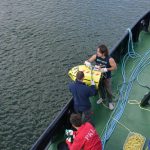The CART (Cooperative Autonomous Robotic Towing system) project develops a new safety oriented concept for salvage operations of distressed vessels. Robots can be a solution for high risk operations
Aproposed concept relies on robotized unmanned marine vehicles able to (semi-)automatically execute the high-risk operation of linking the[ds_preview] emergency towing system of distressed ships to towing vessels. According to the EU’s FP7 measure »Research for Small and Medium Sized Enterprises (SME)«, aiming at supporting innovative company’s in solving technological problems, new concepts of intervention were formulated. That required transfer of know-how from leading research (CNR-ISSIA) and academic (UNIZG-FER) institutions in the field of marine robotics and classification society DNV. The SME CART partners have a lot of know-how in emergency towing devices and salvage operations (PKL) as well as implementation of automation plants (SRS Mecano Instalatie).
CART has the aim of optimizing the operations for safeguarding the environment, helping to prevent oil pollution at sea and minimizing the risk for human lives. In turn, automated Emergency Towing Systems (ETS) provide a cost-effective solution towards disaster risks and the amount of insurance premiums. The concept is based on the idea of using cooperative robotics technology in the eld of unmanned marine vehicles to improve the safety and feasibility of salvage operations by increasing the distance between the tugboat or salvage vessel and the distressed ship. This can be done by using a robotized pickup buoy able to manoeuvre in order to keep a safe position, deployed at sea from the distressed ship in combination with an unmanned semi-submersible vehicle, deployed from the supporting tug-boat, performing the recovery task. It automatically detects the position of the buoy and captures it through a proper circular manoeuvre leading to rope entanglement.
The need of robust robotic platforms required custom design and prototyping, development of suitable techniques to endow the robots with cooperation and coordination capabilities, definition of formal recovery and safety rules for operation execution. During the 18 months of project duration, different systems, platforms and procedures were developed, from laboratory to field scenario, obtaining a reliable prototype for proving the concept of autonomous ship salvage support.
The outcome of the project was composed by two autonomous platform class projects, three platforms developed and tested, cooperative techniques and coordination schemes as well as practical guidelines for system installation and exploitation.
Two full-scale operational scenario experiments were carried out during the CART final trials (July 2013) devoted to the practical validation of the obtained results. A first trial consisted of performing a complete autonomous deployment and recovery of the CART system in protected waters. The scenario was set up in the Muuga Port (Tallinn, Estonia) where PKL provided facilities and tugboats to execute the trials. One boat was elected as »distressed ship« and equipped with one prototype platform acting as autonomous buoy. The task of the tugboat group (tugboat crew plus two people of the CNR-ISSIA team) was to deploy the buoy vehicle in water from the main deck in order to move away from the tugboat once triggered for the launch and thus reaching a safe position. A ground team operated the second autonomous platform from an opposite pier. The distance between tugboat and pier was about 300m. The ground team, acting as salvage unit, had the complete control of the operation, operating both the CART vehicles by means of a Remote Control Station, completing the simulated salvage operation in less than 10 minutes.
A second full scale operation consisted of a complete autonomous deployment and recovery of the CART system in open waters, operating from two vessels. The scenario was set up outside the Muuga Port where two tugboats were provided by PKL, one elected as »distressed ship« and the other one employed as salvage vessel. The successful results of the operation, besides the technical validation of the proposed concept and implemented functionalities, also confirmed the compliance with the project’s practical requirements.
After completion, the coordinator and initial idea proposer (Posidonia srl) is currently exploiting the project results and following-up on the development of engineered automated platforms to be installed and put in service on commercial vessels. At the same time strong efforts are carried out in order to insert inside guidelines, regulation and procedure practice, the recognized employment of robotized platforms in ship salvage scenarios.
Author: Marco Bibuli, Ph.D., Robotics, Automation and Control Engineer,
National Research of Italy CNR – ISSIA
Marco Bibuli





















